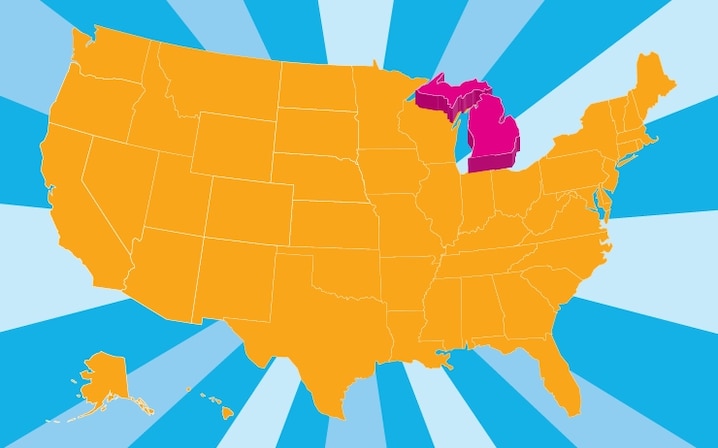Michigan, a state surrounded by four of the five Great Lakes, is the only one in America divided into two distinct peninsulas connected by the five-mile Mackinac Bridge. For families seeking facts about Michigan to share with young explorers, the state’s 3,288-mile freshwater coastline—the longest in the United States—provides endless opportunities for adventure and learning. These facts about Michigan create perfect launching points for educational discussions about American geography and natural resources.
Among the many things to know about Michigan, perhaps most distinctive is its shape resembling a mitten, making it easily recognizable on any map. Despite being called the “Wolverine State,” ironically few wolverines actually inhabit the region—a curious contradiction that children find amusing. The nickname likely originated from the fur trading era or possibly as a result of a territorial dispute with Ohio in 1835. With over 40 percent of its area covered by water (more than any other state), Michigan boasts thousands of lakes, providing habitats for diverse wildlife including white-tailed deer, the state animal, and rare birds like the Kirtland’s warbler.

- Map of Michigan showcasing its unique geographical layout with the Great Lakes. Source: @NatGeo – kids.nationalgeographic.com
The human story of Michigan stretches back an impressive 12,000 years, with Native American tribes like the Kickapoo, Ojibwe, and Potawatomi establishing deep cultural roots long before European settlement. Even today, eleven Native American tribes continue to call Michigan home, preserving their heritage within the state’s diverse cultural landscape. Interesting facts about Michigan include its transition from French control to British rule following the French and Indian War, before eventually becoming a U.S. territory in 1805 and achieving statehood in 1837. For children curious about American history, these facts provide tangible connections to the country’s development.
Detroit, Michigan’s largest city, earned its nickname “Motor City” when automotive pioneers Ransom E. Olds and Henry Ford revolutionized transportation by building some of the first cars in America around 1900. This industrial heritage represents one of the essential things to know about Michigan when understanding America’s economic development. The state’s natural resources extend beyond its famous lakes, with over 90 percent of the Upper Peninsula covered in forests, creating a thriving forestry industry and providing habitats for rebounding populations of native elk and moose that were once extinct in the region.

- Elk in Michigan wilderness, symbolizing the state’s rich natural resources. Source: @NatGeo – kids.nationalgeographic.com
Michigan’s cultural impact extends far beyond its geographical boundaries, with the state giving birth to internationally recognized talents. Facts about Michigan’s famous natives include global superstars Madonna, Diana Ross, and Stevie Wonder, tennis champion Serena Williams, and aviation pioneer Charles Lindbergh. Children learning facts about Michigan are often delighted to discover that many of their favorite celebrities hail from this Midwestern state. Additionally, Motown Records, founded in Detroit in 1959, created a musical revolution that changed American culture forever, producing timeless classics by artists like The Temptations, The Jackson 5, and many others.
The state’s contributions to American innovation extend to unexpected areas, including breakfast tables worldwide. One of the most surprising things to know about Michigan is that Corn Flakes were accidentally invented in Battle Creek in 1898 when the Kellogg brothers’ attempt to make granola resulted in flakes instead. This happy accident revolutionized breakfast habits globally. The Henry Ford Museum in Dearborn celebrates Michigan’s innovative spirit by housing treasures of American ingenuity, including Thomas Edison’s laboratory, an original copy of the Declaration of Independence, and the bus where Rosa Parks made her historic stand for civil rights—providing educational experiences that transform abstract history lessons into tangible encounters for young explorers.
